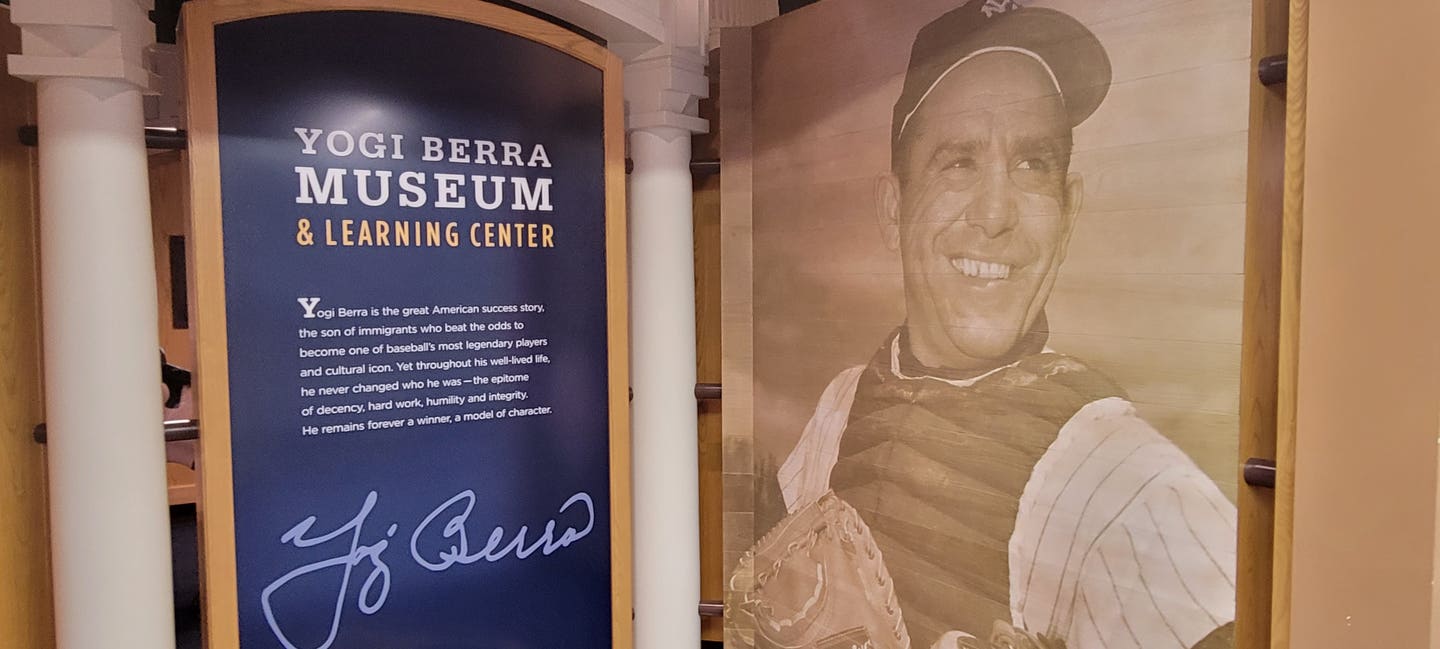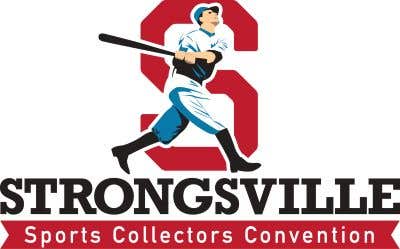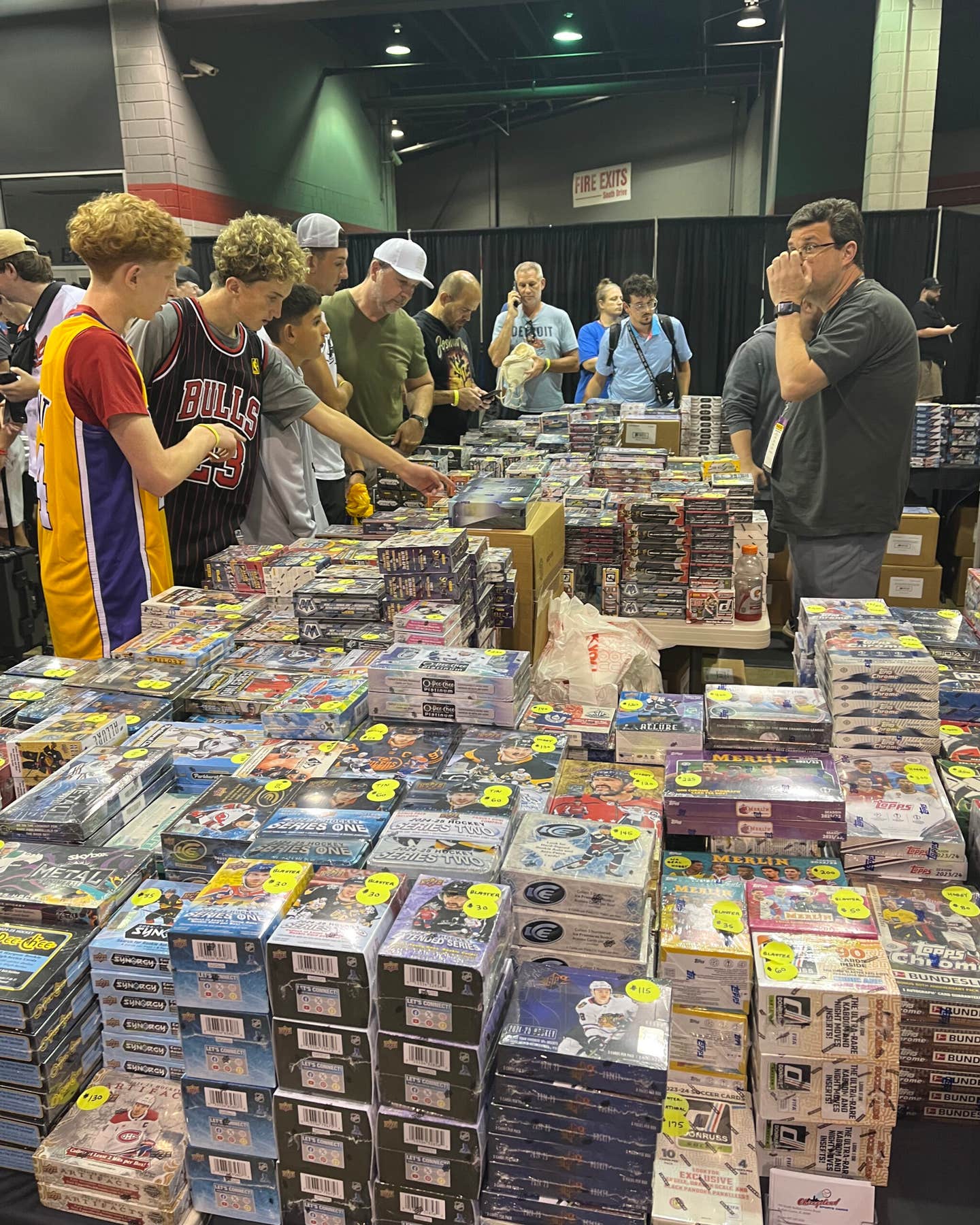
News
Yogi Berra Museum pays tribute to Yankee legend, true American hero
Jack Santelli came away from the Yogi Berra Museum with a whole new appreciation for the all-time Yankee great, not just as an amazing ballplayer but a true American hero.
The attraction, founded 25 years ago by friends and admirers of Berra, is on the campus of Montclair State University in Montclair, N.J., where Berra and his wife, Carmen, raised their three sons Larry, Tim and Dale.
“I've been wanting to come here for years,” said Santelli, who visited with his son-in-law, Lance Del Plato. “We're big baseball fans. I'm a student of the game, have a pretty good knowledge of the game and there's a lot of great things here I never knew of. I really like the pictures and different paintings, a lot of artifacts.”
As a retired, longtime U.S. Marine Corps gunnery sergeant, Santelli was especially impressed with an exhibit detailing Berra's World War II military service as a Navy seaman second class, gunner's mate who took part in the Allied Invasion of Normandy on D-Day.
Yogi's small crew fought on a Landing Craft Support rocket ship. Armed with 12 rockets on each side, they fired on the beach just 300-400 yards off shore, well within range of enemy fire.
“I thought it was like the Fourth of July. Our officer said, ‘You'd better get your head down!’ I just wanted to look at everything,” Berra said.
This and many other highlights from Berra’s life, the epitome of a 20th century American Dream, are captured in “The Boys in the Hall,” a fascinating film hosted by former NBC anchorman Tom Brokaw, which plays continuously in the museum's auditorium where special programs are held.
“I knew Yogi was a fan favorite, I didn't realize how valuable a player he was,” Del Plato said. “I was really impressed by the amount of detail here. They did a great job putting American history in the backdrop.”
Such comments are especially rewarding to museum staff because the facility's complete name is Yogi Berra Museum & Learning Center.
“A lot of the focus is on our education work,” Executive Director Eve Schaenen said. “It's a museum about baseball, of course. But there's a reason the New Jersey Council on the Humanities supports us. It's really the story of a life that tells us something about the American experience. Part of an immigrant family, Yogi grew up on The Hill in St. Louis in the heart of the Italian-American community. His parents spoke Italian in the home.
“He tried out for the St. Louis Cardinals and they ended up picking Joe Garagiola, the kid who literally lived right across the street from Yogi,” Schaenen said.
None other than the great Branch Rickey, a Cardinals executive at the time, told Berra he'd never make the big leagues. Of course, he went on to win a record 10 World Series championships, three MVP Awards (1951, ’54 and ’55) and mentored generations of Yankees long after he retired.
“Jeter, Guidry, Randolph, they all come through here and Yogi was their guy,” Schaenen said.
This theme of overcoming odds and proving naysayers wrong is evident throughout the museum, a source of inspiration and encouragement for every visitor.
Many of Berra's greatest feats are reflected in a vast collection of memorabilia, including bats, balls, game-worn jerseys and equipment. One display case contains a complete set of catcher's gear typical of the 1950s.
“Some items were from the Berra estate, some were from the New York Yankees,” Schaenen said. “A couple of the most valuable pieces were donated personally by George Steinbrenner. A number of items were donated outright by friends and supporters of Yogi. Others were intentionally and thoughtfully bought at auction; things we felt were needed for this kind of museum.”
The items donated by Steinbrenner include original plaques dedicated to Mickey Mantle and Joe DiMaggio that once adorned the outfield wall at the original Yankee Stadium.
Just inside the main entrance, guests are treated to a collection of bats autographed by Berra, Babe Ruth, Hank Aaron, Roberto Clemente, Sadaharu Oh, Derek Jeter, David Ortiz and Mo'ne Davis, the first girl to throw a shutout in Little League World Series history (2014).
There's also hands-on experiences such as the Mitt Mobile, a collection of 16 vintage catcher's gloves that tell the story of how Berra's position and baseball itself has evolved from the Deadball Era to the present.
Next, kids and adults alike can loosen up their arms by throwing balls in a PITCH machine that records speeds with a radar gun.
“That's one of the first pieces we commissioned after Yogi passed away in 2015,” Schaenen said. “The question was, ‘How are we going to keep this place lively and alive?’ Collectors will always love to see baseball cards, rings and trophies. They're beautiful items. But for a new generation not familiar with the history of the game, how do you engage those young people? PITCH is a good way to do it.
“While a lot of the museum is about nostalgia and collecting, we are very mindful that technology is driving a lot of the museum experience these days,” she said. “So we're currently working on an exhibit that will incorporate augmented reality, emerging technology that allows you to layer content digitally on top of what's already there.”
Yogi's longtime friend and fellow Yankee Hall of Famer Phil Rizzuto lived nearby in New Jersey. A life-size, pinstriped Holy Cow statue (as a broadcaster, Scooter yelled “How Cow!” whenever a Yankee made a great play) is covered with autographs from countless baseball celebrities, from David Cone to sportscaster Bob Costas. The list includes dozens of Yankees, such as Don Mattingly, Mariano Rivera and Andy Pettitte.
The most colorful display is a collection of 76 paintings called “New York City's Golden Boys” by renowned baseball artist Andy Jurinko. It depicts the many great players and their iconic ballparks (Yankee Stadium, Ebbets Field, the Polo Grounds) that defined Berra's era when New York boasted three major league clubs.
Paintings include the likes of Willie Mays, Roy Campanella, Duke Snider and many of Berra's Yankee teammates, such as pitching greats Allie Reynolds and Whitey Ford.
In 2020, in conjunction with the Negro Leagues Museum in Kansas City, the Berra Museum featured “Discover Greatness,” an exhibit honoring the Negro Leagues' 100th anniversary with 90 photographs and numerous artifacts, illustrating the rich history of Negro League baseball from the late 1800s to the 1960s.
Also See: Top Mickey Mantle cards for collectors
There's currently an exhibit dedicated to tennis champion Billie Jean King, highlighting the role of women in sports. Plans call for a new exhibit outlining the impact of COVID on baseball.
“Looking farther ahead, we'd like to do a community-sourced exhibit where folks can loan or donate their memorabilia to put on display here,” Schaenen said. “This happened a lot with the Negro Leagues show. People called up and said, ‘Hey, my grandfather had a Newark Eagles cap signed by the entire 1946 Colored World Series championship team. Would you like to show it?’
“We realize so many valuable items are in private collections,” she said. “We want to reach out to the public with a call to action and say, ‘We're going to recreate somebody's trophy den here at the museum. What can you show?’ Then we'll vet the items and decide what to put into the show.”
In October 2014, the museum suffered a major setback when thieves broke in and stole Berra's World Series rings and two of his three MVP Awards during a series of thefts of more than $4 million of art and sports memorabilia from several small museums between 1999-2019.
A gang of 10 thieves from Pennsylvania were arrested for the thefts in June and indicted on several charges, including conspiracy to commit theft of major artwork and interstate transportation of stolen property.
But the Berra museum eventually wound up with more artifacts than it had prior to the break-in. In addition to his great Yankee career, Berra played briefly for the Mets in 1965, became a coach and managed the team from 1972-75.
Major League Baseball, the Yankees and Mets donated replicas of all stolen items and many things not previously in the museum's collection. The list includes Berra's 10 championship rings as a player, every New York Yankees World Championship ring and a pocket watch from the 1927 team. The Mets donated 1969 World Championship and 1973 National League championship rings.
Yogi's reaction to the break-in says a great deal about his character as a first-class human being.
“His immediate response was, ‘Can the kids still come?’ So that tells you where he was at,” Schaenen said. “Yogi wasn't just a Hall of Fame ballplayer, he was a Hall of Fame person, 100 percent authentic. He didn't care what your background was, what your social class was, how much money you earned. He cared about what kind of person you were.
“That's one of those wonderful qualities that allows us to sustain his legacy. That's what this museum represents, his values as much as anything else.”








